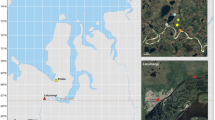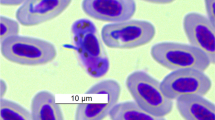Abstract
We studied the prevalence and intensity of the haemosporidian blood parasite Haemoproteus payevskyi in great reed warblers at Lake Kvismaren (6 years) and Lake Segersjö (3 years) in Sweden. Based on microscopic inspection of slides from 282 adult birds, 20.6% showed infection of H. payevskyi in circulating red blood cells in at least 1 year. For parasite prevalence, there was no difference between years, sex, and age classes. However, parasite intensity was higher in females than in males, and this was most pronounced in 1-year-old birds. Individuals scored to carry parasites in yearn were more likely to show parasite infection yearn + 1 than birds scored to be parasite-free in yearn. None of 99 juvenile birds examined at the breeding site in late summer, 4–9 weeks after hatching, showed infection of H. payevskyi. Parasite intensity in infected adult birds decreased in the course of the breeding season and no new or relapse infections were observed during this period. Thus, our data imply that in the great reed warbler, a long-distance migrant to tropical Africa, transmission of H. payevskyi occurs on wintering sites or at stopover sites during migration.

Similar content being viewed by others
References
Allander K, Bennett GF (1994) Prevalence and intensity of haematozoan infection in a population of great tits, Parus major, from Gotland, Sweden. J Avian Biol 25:69–74
Allander K, Sundberg J (1997) Temporal variation and reliability of blood parasite levels in captive yellowhammer males Emberiza citrinella. J Avian Biol 28:325–330
Ashford RW (1971) Blood parasites and migratory fat at Lake Chad. Ibis 113:100–101
Atkinson CT, van Riper C III (1991) Pathogenicity and epizootiology of avian haematozoa: Plasmodium, Leucocytozoon and Haemoproteus. In: Loye JE, Zuk M (eds) Bird–parasite interactions: ecology, evolution and behaviour. Oxford University Press, Oxford, pp 19–48
Bennett GF, Sikamaki P, Jokimaki J, Hovi M, Huhta E (1995) Leucocytozoon muscicapa n. sp. (Leucocytozoidae: Apicomplexa) from the pied flycatcher Ficedula hypoleuca (Pallas) (Passeriformes: Muscicapinae). Syst Parasitol 31:33–36
Bensch S (1996) Female mating status and reproductive success in the great reed warbler: is there a potential cost of polygyny that requires compensation? J Anim Ecol 65:283–296
Bensch S, Åkesson S (2003) Temporal and spatial variation of haematozoan in Scandinavian willow warblers. J Parasitol 89:388–391
Bensch S, Hasselquist D (1991) Territory infidelity in the polygynous great reed warbler, Acrocephalus arundinaceus: the effect on variation in territory attractiveness. J Anim Ecol 60:857–871
Bensch S, Hasselquist D (1994) Higher rate of nest loss among primary than secondary females: infanticide in the great reed warbler? Behav Ecol Sociobiol 35:309–317
Bensch S, Hasselquist D, Nielsen B, Hansson B (1998) Higher fitness for philopatric than for immigrant males in a semi-isolated population of great reed warblers. Evolution 52:877–883
Bensch S, Stjernman M, Hasselquist D, Östman Ö, Hansson B, Westerdahl H, Torres Pinheiro R (2000) Host specificity and host switching in avian haematozoa: a study of Plasmodium and Haemoproteus mtDNA amplified from avian blood. Proc R Soc Lond B 267:1583–1589
Bensch S, Waldenström J, Jonzén N, Westerdahl H, Hansson B, Sejberg D, Hasselquist D (2007) Temporal dynamics and diversity of avian malaria parasites in a single host species. J Anim Ecol 76:112–122
Cramp S (1992) Handbook of the birds of Europe the Middle East and North Africa, vol 6. Oxford University Press, Oxford
Dale S, Kruszewicz A, Slagsvold T (1996) Effects of blood parasites on sexual and natural selection in the pied flycatcher. J Zool 238:373–393
Davidar P, Morton ES (1993) Living with parasites: prevalence of a blood parasite and its effect on survivorship in the purple martin. Auk 110:109–116
Dawson RD, Bortolotti GR (2000) Effects of haematozoan parasites on condition and return rates of American kestrels. Auk 117:373–380
De Roo A, DeHeegher J (1969) Ecology of the great reed warbler, Acrocephalus arundinaceus (L), wintering in the southern Congo savannah. Gerfaut 59:260–275
Desser SS, Bennet GF (1993) The genera Leucocytozoon, Haemoproteus and Hepatocystis. In: Kreier JP (ed) Parasitic protozoa, vol 4. Academic press, New York, pp 273–307
Dyrcz A (1986) Factors affecting facultative polygyny and breeding results in the great reed warbler, Acrocephalus arundinaceus. J Ornithol 127:447–461
Dyrcz A (1988) Mating systems in European marsh-nesting Passeriformes, vol 2. Acta XIX Congress Internationalis Ornithologie, Ottawa, pp 2613–2623
Folstad I, Karter AJ (1992) Parasites, bright males, and the immunocompetence handicap. Am Nat 139:602–622
Freeman-Gallant C, O’Connor KD, Breuer ME (2001) Sexual selection and the geography of Plasmodium infection in Savannah sparrows (Passerculus sandwichensis). Oecologia 127:517–521
Gregory RD, Montgomery SSJ, Montgomery WI (1992) Population biology of Heligmosomoides polygyrus (Nematoda) in the wood mouse. J Anim Ecol 61:749–757
Gylfe Å, Bergström S, Lundström J, Olsen B (2000) Reactivation of Borrelia infection in birds. Nature 403:724–725
Hall S (1996) The timing of post-juvenile moult and fuel deposition in relation to the onset of autumn migration in reed warblers Acrocephalus scirpaceus and sedge warblers Acrocephalues schoenobaenus. Ornis Svec 6:89–96
Hasselquist D (1995) Demography and lifetime reproductive success in the polygynous great reed warbler. Jpn J Ornithol 44:181–194
Hasselquist D (1998) Polygyny in great reed warblers: a long-term study of factors contributing to male fitness. Ecology 79:2376–2390
Hasselquist D, Bensch S, Ottosson U (1993) Diurnal song pattern in the great reed warbler. Ornis Svec 3:125–136
Hasselquist D, Bensch S, von Schantz T (1996) Correlation between song repertoire, extra-pair paternity and offspring survival in the great reed warbler. Nature 381:229–232
Hasselquist D, Lindström Å, Jenni-Eiermann S, Koolhaas A, Piersma T (2007) Long flights do not influence the immune responses of a long-distance migrant bird. J exp Biol 210:1123–1131
Hedenström A, Bensch S, Hasselquist D, Lockwood M, Ottosson U (1993) Migration, stopover and moult of the great reed warbler Acrocephalus arundinaceus in Ghana, West Africa. Ibis 135:177–180
Hellgren O, Waldenström J, Perez-Tris J, Szöllösi E, Hasselquist D, Krizanauskiene A, Ottosson U, Bensch S (in press) Detecting shifts of transmission areas in avian blood parasites—a phylogenetic approach. Mol Ecol 16:1281–1290
Korpimäki E, Tolonen P, Bennett GF (1995) Blood parasites, sexual selection and reproductive success of European Kestrels. Ecosciénce 2:335–343
Lessells CM, Boag PT (1987) Unrepeatable repeatabilities: a common mistake. Auk 104:116–121
Merino S, Potti J (1995) High prevalence of hematozoa in nestlings of a passerine species, the pied flycatcher (Ficedula hypoleuca). Auk 112:1041–1043
Møller AP, Erritzøe J (1998) Host immune defence and migration in birds. Evol Ecol 12:945–953
Nelson RJ, Demas GE (1996) Seasonal changes in immune function. Q Rev Biol 71:511–548
Olsen NJ, Kovacs WJ (1996) Gonadal steroids and immunity. Endocr Rev 17:369–384
Oppliger A, Christe P, Richner H (1997) Clutch size and malarial parasites in female great tits. Behav Ecol 8:148–152
Peirce MA, Mead CJ (1978) Haematozoa of British birds III. Spring incidence of blood parasites of birds from Hertfordshire, especially returning migrants. J Nat Hist 12:337–340
Pérez-Tris J, Bensch S (2005) Dispersal increases local transmission of avian malarial parasites. Ecol Lett 8:838–845
Råberg L, Grahn M, Hasselquist D, Svensson E (1998) On the adaptive significance of stress-induced immunosuppression. Proc R Soc Lond B 265:1637–1641
Richner H, Christe P, Oppliger A (1995) Paternal investment affects prevalence of malaria. Proc Natl Acad Sci USA 92:1192–1194
Ricklefs RE, Fallon SM, Bermingham E (2004) Evolutionary relationships, cospeciation, and host switching in avian malaria parasites. Syst Biol 53:111–119
Rintamäki PT, Halonen M, Kilpimaa J, Lundberg A (1997) Blood parasites found in three passerine species during spring migration. Ornis Fenn 74:195–200
Rogers D, Randolph SE (2000) The global spread of malaria in a future, warmer world. Science 289:1763–1766
Sejberg D, Bensch S, Hasselquist D (2000) Nestling provisioning in polygynous great reed warblers: do males bring larger prey to compensate for fewer nest visits? Behav Ecol Sociobiol 47:213–219
Sokal RR, Rohlf JF (1981) Biometry. Freeman, New York
Sol D, Jovani R, Torres J (2000) Geographical variation in blood parasites in feral pigeons: the role of vectors. Ecography 23:307–314
Sol D, Jovani R, Torres J (2003) Parasite mediated mortality and host immune response explain age-related differences in blood parasitism in birds. Oecologia 135:542–547
SPSS Inc (2000) SYSTAT 10.0 for windows. SPSS Inc, Evanston
Sturkie PD, Benzo CA (1986) Avian physiology. Springer, Berlin
Valkiūnas G (1993) The role of seasonal migrations in the distribution of Haemosporidia of birds in North Palaearctic. Ekologija (Vilnius) 2:57–67
Valkiūnas G (2005) Avian malaria parasites and other haemosporidia. CRC, Boca Raton
Valkiūnas G, Iezhova TA (2001) A comparison of blood parasites in three subspecies of the yellow wagtail Motacilla flava. J Parasitol 87:930–934
Valkiūnas G, Zehtindjiev P, Hellgren O, Ilieva M, Iezhova TA, Bensch S (2007) Linkage between mitochondrial cytochrome b lineages and morphospecies of two avian malaria parasites, with a description of Plasmodium (Novyella) ashfordi sp. nov. Parasitol Res (in press)
Waldenström J, Bensch S, Kiboi S, Hasselquist D, Ottosson U (2002) Cross-species infection of blood parasites between resident and migratory songbirds in Africa. Mol Ecol 11:1545–1554
Waldenström J, Bensch S, Hasselquist D, Östman Ö (2004) A new nested polymerase chain reaction method very efficient in detecting Plasmodium and Haemoproteus infections from avian blood. J Parasitol 90:191–194
Weatherhead PJ, Bennett GF (1991) Ecology of red-winged blackbird parasitism by haematozoa. Can J Zool 69:2352–2359
Weatherhead PJ, Bennett GF (1992) Ecology of parasitism of brown-headed cowbirds by haematozoa. Can J Zool 70:1–7
Wedekind C, Folstad I (1994) Adaptive or non-adaptive immunosuppression by sex hormones? Am Nat 143:936–938
Westerdahl H, Waldenström J, Hansson B, Hasselquist D, von Schantz T, Bensch S (2005) Association between malaria and MHC in a migratory songbird. Proc R Soc Lond B 272:1511–1518
Westneat DF, Birkhead TR (1998) Adapative hypotheses linking the immune system and mate choice. Proc R Soc Lond B 265:1065–1073
Zuk M (1990) Reproductive strategies and disease susceptibility: an evolutionary viewpoint. Parasitol Today 6:231–233
Zuk M, McKean KA (1996) Sex differences in parasite infections: patterns and processes. Int J Parasitol 26:1009–1024
Acknowledgements
We wish to thank Bo Nielsen, Anna-Karin Olsson, Bengt Hansson, Helena Westerdahl, Martin Stervander, Douglas Sejberg for extensive help with data collection in the field. This study was financially supported by the Swedish Research Council (NFR/VR), Swedish Research Council for Environment, Agricultural Sciences and Spatial Planning (Formas), Royal Swedish Academy of Sciences (Ahlstrands, Hierta-Retzius), Crafoord Foundation, Carl Tryggers Foundation, Lunds Djurskyddsfond. This is report no.149 from the Kvismare Bird Observatory.
Author information
Authors and Affiliations
Corresponding author
Additional information
Communicated by F. Bairlein.
Rights and permissions
About this article
Cite this article
Hasselquist, D., Östman, Ö., Waldenström, J. et al. Temporal patterns of occurrence and transmission of the blood parasite Haemoproteus payevskyi in the great reed warbler Acrocephalus arundinaceus . J Ornithol 148, 401–409 (2007). https://doi.org/10.1007/s10336-007-0144-2
Received:
Revised:
Accepted:
Published:
Issue Date:
DOI: https://doi.org/10.1007/s10336-007-0144-2




